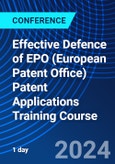Clarity in drafting patent claims has always been a serious issue: clarity is required to distinguish the subject matter of a claim from prior art, and an unclear claim can be interpreted to the disadvantage of the applicant or proprietor. This is not just a formal matter, but a substantial issue of first importance.
The ‘problem-solution’ approach is not officially part of the EPC, but is a criterion which has been developed by case law. It is now hard to find a decision of the Boards of Appeal which does not rely on the problem-solution approach in order to decide upon an inventive steps. It looks easy, but when applied, it should be applied correctly.
The purpose of this seminar is to teach delegates the essentials of clarity and the most effective use of the problem-solution approach, giving them an edge over other parties.
Key topics covered:
- Article 84 - the implications of clarity of claims
- Effective use of the problem-solution approach
- Article 56 - understanding inventive step
Certification:
- CPD: 6 hours for your records
- Certificate of completion
Agenda
This course runs from 09:00-17:30
Understanding the implications of clarity of claims - Article 84
- Definition of clarity - Art 84
- Categories and types of claims
- Practical definition of clarity - clear means
- Conciseness and support by description
- Form and content of claims
- Clarity vs novelty
- Structural vs functional features
- Comprising vs consisting
- The interplay between Art 83, 84 and 56
- Relative terms
- Inventions defined by parameters
- Definition by result to be achieved
- Sources of difficulties with Article 84 - illustrating case law
- Clarity of claims in opposition procedure
- Application of G 3/14 to amended claims
- Adaptation of the description
PRACTICAL WORKSHOP 1
Exercises to exemplify the concepts learnt from 'Understanding the implications of clarity of claims - Article 84'
Inventive step and how to master the problem-solution approach - Article 56
- Legal definition
- State of the art
- Obvious
- Problem-solution approach - identifying the nearest/closest prior art
- Formulating the objective technical problem
- Does the claimed subject matter solve the objective problem?
- Partial problems
- Aggregation/juxtaposition
- Mix of technical and non-technical features
- Deciding on inventive step and positive pointers
PRACTICAL WORKSHOP 2
Exercises to exemplify the concepts learnt from 'Inventive step and how to master the problem-solution approach - Article 56'
Latest case law and its implications for defending your EPO patent applications
- Notable decisions on inventive step
Speakers

Mr Daniel X Thomas,
Training Patent Specialist ,
EPODaniel X. Thomas is an electronics engineer by training. He started his career in the patent field as search examiner at the former Institut International des Brevets in The Hague in 1971. After incorporation of the IIB into the EPO in 1978, he was search examiner in the EPO’s DG1. He joined the EPO’s DG2 in 1979 as substantive examiner in the field of computers and memories. He became a Director in DG2 in 1989, and subsequently headed directorates in various fields of electronics, physics and mechanics.
Although he retired from active service at the EPO on 1 January 2013, Daniel continues to be active in the field of training patent specialists. He still regularly gives lectures at different universities over Europe, including CEIPI in Strasbourg, and also leads workshops/seminars relating to various aspects of the European granting procedure for the epi and the Academy of the EPO, including preparation of candidates for the European Qualification Examination, and also ‘grandfathers’ for new Contracting States.
Who Should Attend
- European patent attorneys
- Patent attorneys in private practice
- Corporate patent attorneys and lawyers
- People working or training in intellectual property
- US attorneys working in Europe
- Trainee patent attorneys
- EQE candidates
Those already familiar with the field will find these seminars valuable for updating their knowledge on the latest case law and its implications.









